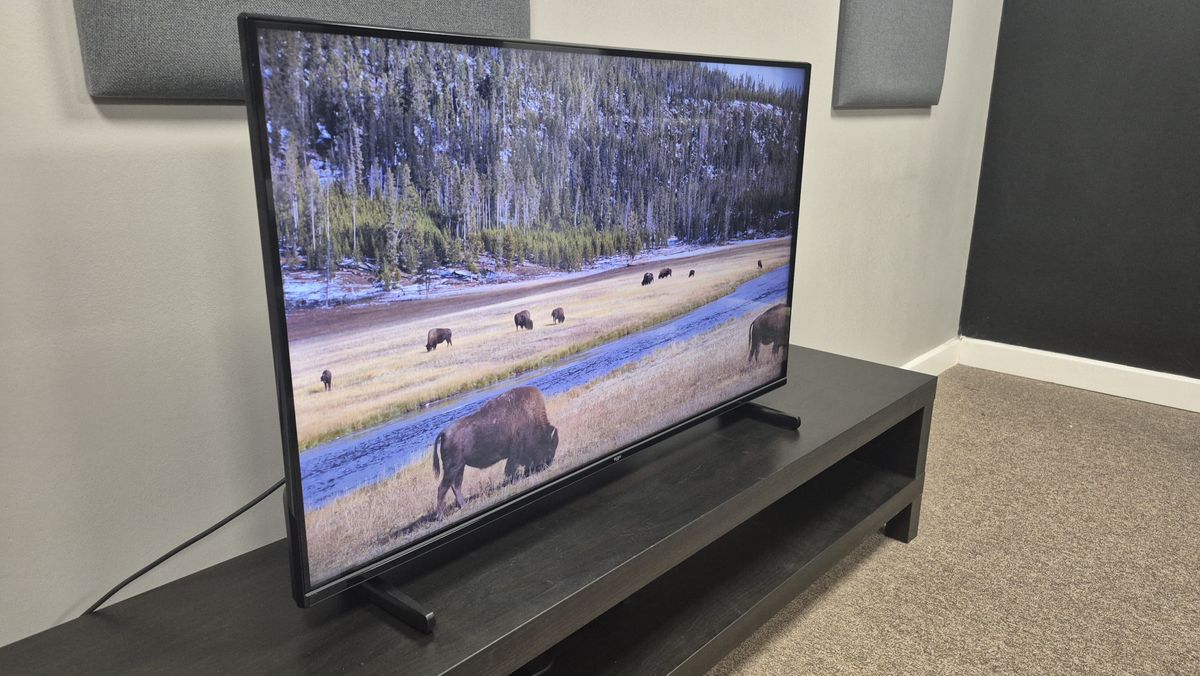
The Bush 43UT24SB offers a vivid QLED display, modern audio-visual features like Dolby Atmos and Dolby Vision and solid gaming performance, all for less than £250. So, if the time has come and you need a new TV, but you’re not looking to spend an arm and a leg on it, you’re in luck.
As well as boasting an ultra-low price, the Bush 43UT24SB has a fairly unique feature, in that it harnesses the perhaps lesser-known TiVo operating system, rather than say Fire TV or Android. So, let’s start with that.
After going through a simple start-up process and setting the TV to Natural mode, I was met with a straightforward, stylistically pleasant menu. The selling point here is that you can sift through a bunch of movies or TV shows instantly without having to enter a specific app. This can be great if you’re not sure what to watch – as you get a great overview of all the new and popular options available, without needing to search through each platform one by one. There’s a small icon to note which apps have a particular show or movie, though, so you’ll easily be able to find out whether you have the appropriate subscription.
You do still get the apps – including Disney Plus, Netflix, YouTube and more – separately listed near the top of the menu, however. And generally, the TiVo interface is extremely easy to navigate and use, which is unsurprising as other than the way content is separated, it functions very similarly to competitors – there’s nothing majorly different to get to grips with. On the Bush 43UT24SB, I found surfing through menus to be decently sharp, although there was sometimes a little bit of delay when quickly moving through the interface – something that’s common with even some of the best small TVs.
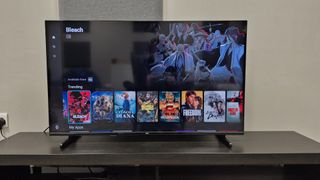
But reader, I don’t want to keep you from the main event here, so let’s dive right in and talk picture quality. Of course, I wasn’t expecting a perfectly accurate display or insanely vibrant colours here, but the overall picture is still very impressive for a sub-£250 TV. When watching The Boy and the Heron on Netflix, Natsuko’s green eyes looked rich and didn’t appear washed or too dark. Her orange and yellow garment – alongside the protagonist Mahito’s blue tunic – didn’t look oversaturated and details like buttons came through clearly. I felt that colour accuracy was impressive for the price – and that was reflected decently with measurements, where DCI-P3 was 92% and BT.2020 was 68.3% – not bad for a cheap 43-inch display.
The impressive picture was undoubtedly lifted by Dolby Vision, which is a great inclusion for such a cheap TV. For instance, I flicked on John Wick: Chapter 2 and the vibrancy of yellow taxis, for instance, was striking – and contrast against the darkness of the environment was pleasing too. On that note, dark rooms and clothing had pretty solid black levels. John Wick’s suit, for example, didn’t suffer too much from the grey-ish tint a lot of cheaper QLED or LED displays inflict on dark details. And even generally, Dolby Vision amplified the quality of details, with elements like sweat droplets and face markings appearing defined and surprisingly true-to-life.
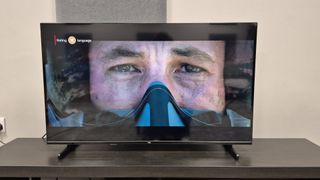
For reference, I predominantly watched movies using Dolby Vision Dark, although there is an alternative Light mode. Light mode offers more aggressive brightness, which some may enjoy, but the improved accuracy of Dark mode looked better to me in a variety of lighting conditions. If you’re watching content that’s not Dolby Vision compatible, there are plenty of other picture modes to choose from too. Some, like Dynamic, are best avoided – colours simply look too bright and oversaturated. Natural mode is toned down a bit and looks solid, but the best non-Dolby Vision option was Cinema in my view, which illuminates details with more finesse, doesn’t look overly bright and does quite a good job at replicating skin tones and textures accurately.
One minor complaint I will raise, though, is that motion isn’t exactly stunning on this display. It’s still undoubtedly adequate, although during the opening bike chase scene in John Wick: Chapter 2 there was some noticeable judder. This wasn’t too jarring though and even when playing Battlefield V on the XBox Series X, I found motion to be totally serviceable and gameplay to be smooth.
On top of that, I tested input lag, which was just 10.6 ms – that’s more than good enough for the average gamer. Furthermore, you get features like ALLM (Auto Low Latency Mode), which enables the TV to automatically switch to the lowest latency mode for the smoothest possible experience. So, even if you’re not gonna get top-of-the-range performance aspects like 120fps frame rates, gaming still feels good on the Bush 43UT24SB, given the price you pay.
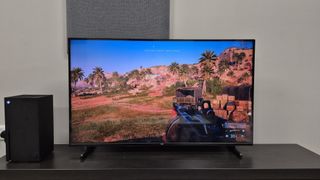
Another aspect of performance that impressed me was sound quality. Now, I’ll be clear – you’re not getting mind-blowing audio or anything here and you’ll get a much fuller sound with one of the best cheap soundbars. However, for a £200-£250 TV, I was served with a decent helping of weight in the low-end. The roar of jet engines in Top Gun: Maverick, for example, were translated with noticeable, albeit not ground-shaking power. I also found when watching Sky News on YouTube that vocal clarity was totally passable – just don’t expect wonders at top volumes. The width and placement of sounds is quite strong too, in part thanks to Dolby Atmos and – although you’re not getting ‘true’, deeply immersive Atmos – depth is commendable for a TV of this size.
So really, I have very few complaints about the Bush 43UT24SB. If I was to nitpick, I would say that the included remote does feel very cheap – it’s super light, plasticky and can have a little bit of delay with some inputs. However, it does have some handy buttons for accessing top apps or using the TiVo voice controls, which are surprisingly intuitive – you can ask fairly general questions about what to watch, for instance, and you’re met with a set of appropriate options.
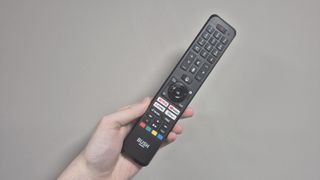
Similarly to the remote, the TV isn’t the most sleek and attractive, plus it doesn’t have the best build quality. I also found when attaching the foot stands that they weren’t the sturdiest – so this Bush set doesn’t scream quality before pressing the on-switch. One more small issue I had, was that some apps would function, although video and audio would stop appearing, which only happened twice but could be frustrating in the long run. But otherwise, there’s little to bemoan.
Overall, then, the Bush 43UT24SB is a fantastic cheap QLED TV, which offers tasty picture quality, impressive audio, exciting modern features and a neat user interface. If you’re looking for an inexpensive 43-inch TV or a strong secondary screen this is definitely worth considering and unless you want a top TV for gaming or a near-flawless picture, I’d recommend it as a superb budget option.
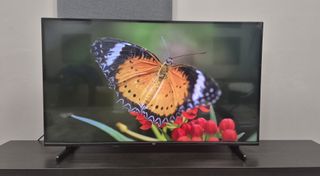
Bush 43UT24SB review: price & release date
- £250 RRP, though often available for less
- Launched in 2024
The Bush electronics brand is owned by Sainsbury’s and so this TV is exclusively available via Argos (which was acquired by Sainsbury’s in 2016). The Bush 43UT24SB has an excellent low RRP of just £250 – you’re not going to find a great deal of decent quality 43-inch QLED TVs in that ballpark. But it gets even better. Despite launching in 2024, I’ve already spotted this TV available at a discounted price. At the time of writing, for instance, the Bush 43UT24SB is available for £229.99, so you’re looking at top-drawer value here.
Bush 43UT24SB review: Specs
| Screen type | QLED |
| Refresh rate | 60Hz |
| HDR | HDR10, HLG |
| Audio | Dolby Atmos, DTS HD |
| Smart TV | TiVo |
| HDMI ports | 3x HDMI (including HDMI 2.1 eARC) |
Should I buy the Bush 43UT24SB?
| Attributes | Notes | Rating |
|---|---|---|
| Features | Dolby Atmos and Vision, ALLM, TiVo voice assistant – very strong for the price. | 4/5 |
| Picture quality | Pleasingly bright, vivid display with impressive accuracy and black levels. | 4/5 |
| Sound quality | Good bass levels, OK vocals, imperfect at higher volumes. | 3.5/5 |
| Design | Cheap-looking remote, decent but not beautiful looking, stand isn’t great. | 2.5/5 |
| Smart TV & menus | User-friendly TiVo interface, some delay during menu navigation. | 4/5 |
| Gaming | Up to scratch motion, ALLM, Dolby Vision for gaming, but no 120Hz. | 4/5 |
| Value | Great picture quality and audio for just over £200 – it doesn’t get much better. | 5/5 |
Buy it if…
Don’t buy it if…
Bush 43UT24SB review: Also consider
| Header Cell – Column 0 | Bush 43UT24SB | Amazon Fire TV Omni QLED | TCL 32S5400 |
|---|---|---|---|
| Price | £250 | £549 | £179 |
| Screen type | QLED | QLED | LED |
| Refresh rate | 60Hz | 60Hz | 60Hz |
| HDR | HDR10, HLG | Dolby Vision IQ, HDR10+ Adaptive, HDR10, HLG | HDR10, HLG |
| Smart TV | TiVo | Fire TV | Android TV |
| HDMI ports | 3x HDMI (including HDMI 2.1 eARC) | 4 (1x HDMI 2.1 eARC) | 2x HDMI 1.4 |
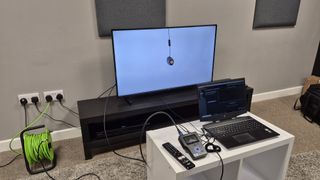
How I tested the Bush 43UT24SB review
- Assessed in Future Labs TV testing room in various lighting conditions
- Took measurements with Portrait Displays’ Calman software
- Tested using a range of sources, both SDR and HDR
I used a number of sources to test picture quality on the Bush 43UT24SB across both HDR and SDR. This included Netflix, YouTube and a selection of Blu-rays played using the Panasonic DP-UB820 4K Blu-ray player. I also played games on the XBox Series X to cover gaming performance.
When watching the Bush 43UT24SB, I chose video content that would highlight performance in some key areas. For instance, I watched The Boy and the Heron and John Wick 2 predominantly to assess aspects such as colour fidelity, contrast and motion. I also watched Top Gun: Maverick and Sky News – predominantly to judge sound quality.
On top of that, I took measurements with Portrait Displays’ Calman calibration software. I measured peak brightness on a 10% window and 100% window in both SDR and HDR. I then recorded the Delta-E values (which demonstrates the margin of error between the test pattern and what is displayed) for colour accuracy, greyscale and gamma. I also measured the colour space looking at DCI-P3 and BT.2020 coverage. For all tests, I used the Murideo Six 8K test pattern generator. You can read all about how we test TVs at that link.
- First reviewed: January 2025
- Read more about how we test
